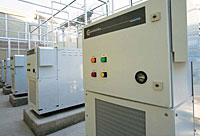It was the second state-of-the-art Wal-Mart Supercenter to open this year. Like the McKinney, Texas store, which was detailed in the Sept. 5 issue of The NEWS, the Colorado-based center contains dozens of experimental energy-saving technologies. In fact, this store has some additional unique heating, cooling, and refrigeration aspects.
EVAPORATIVE COOLING
For one, the Aurora store uses indirect evaporative cooling. According to a company release, water is sprayed into the airstream, and as it evaporates, the air is cooled. The absorption chiller is designed to provide additional cooling on the hottest days of the year."This evaporative air conditioning system uses less energy than a standard refrigerated air conditioning system," stated the company.

SOLAR WALL
The south-facing wall of the store is covered with a perforated metal siding. Heat buildup from the sun warms the air in the cavity between the metal siding and the building wall by 10° to 20°, de- pending on the season and weather conditions. The warm air rises to the top of the wall by heat convection. The store's ventilation system then draws that warmed air into the store."This ‘natural' pre-heating system means less energy is needed to run the mechanical heating system and less natural gas is needed to heat the store," said Wal-Mart officials. According to the company, in the summer, the warm air generated by the wall does not enter the store, but is released at the top of the wall. The wall acts as a solar shield, it said, reducing solar heat gain and reducing cooling needs in the stockroom.
COGENERATION PLANT
The store has been equipped with a cogeneration system that includes an absorption chiller. The on-site distributed generated power plant consists of six 60-kW microturbines and a cooling tower. The turbines run on natural gas. The technology delivers electricity, cooling, and heating.
The cogeneration system is de-
signed to operate with the community grid or alone as an independent power plant. During a utility power outage, the microturbines are designed to provide backup power as part of the refrigeration system.
SECONDARY REFRIGERATION
Glass doors have been installed on the display cases to keep the cold air in and reduce energy consumption.
The secondary loop approach is used on medium-temperature refrigeration. The glycol is pumped to display cases through ABS (acrylonitrile-butadiene-styrene) piping, which Wal-Mart said "is simpler and less expensive to install than copper piping."
Overall, the company said the use of glass door display cases, high-efficiency fan motors, and evaporative condensing refrigeration will save the retail giant 750,000 kW-hours of energy annually.
Among manufacturers cited by Wal-Mart as being involved in the project were Ductsox Corp., Emerson Climate Technologies, Hill Phoenix, and Solar Integrated Technologies.
Publication date: 01/09/2006


Report Abusive Comment